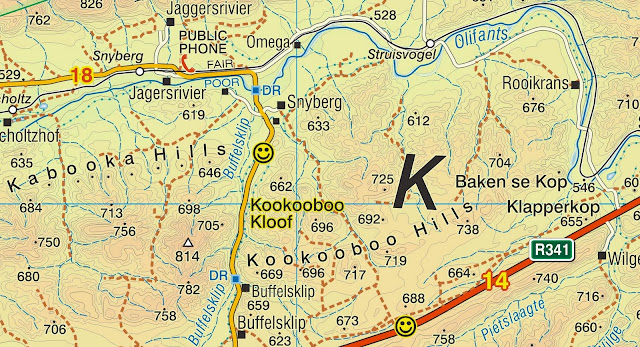One of the most frequent questions with which I am assailed by both my fans is this: do you think maps are still relevant in this techno age of GPS and Google Earth? - and if so, why?
I reply [with no hint of bias], "Of course they are!"
An outstanding feature of the age of techno is how easily we humans are seduced into believing wrong stuff about our newly-invented tools (because that's what all these gaudy gimgaws are - just tools, like hammers or stone hand-axes). People once believed that computers would be the end of paper documents. They believed that newspapers would disappear in the face of the internet. They still believe that using a credit card on the internet is dangerous, whereas it's actually the safest place you can use one. People believe that GPS machines are infallibly accurate. They believe that cellphone mast-transmissions will cause babies to be born with four legs, and some even believe that the Chinese are civilized.
 |
| Great for tracking Afrika ... |
GPS stands for "global positioning system" and it relies upon bouncing radio signals off fixed-orbit satellites to "triangulate" or calculate, by fairly simple mathematics, exactly where you are on the planet. There are two types of GPS machines - those that record a track of your movements in relation to the Earth's surface, and those that are pre-loaded with tracks or points so that you can punch in a placename and the machine will [theoretically] direct you to it. It's often supposed to to do this via the shortest route, but don't hold your breathe.
A map, by contrast, is a picture of a part of the Earth's surface that helps you to see one place in relation to another.
I repeat: "that helps you to see one place in relation to another."
In a nutshell, a GPS reader will direct you to a place whose name you already know and which you want to get to. It won't tell you what's on the other side of those mountains. It has a dinky little screen with a teeny-weeny little maplet on it, but it's like looking through a keyhole. A map, on the other hand, is a magnificent sheet of paper filled with information about roads and mountain ranges and towns and places of interest, and you can spread it out on the table and see all these marvellous things at a glance and how they relate to each other.
 |
| Don't try spreading this out across your table ... |
People forget that, just as maps are only as good as the cartographers who drew them, GPS readers are only as good as the info which a human being pre-loaded into them. They often hold massive amounts of info of which lots and lots is incorrect. Of course it is - they are programmed by humans! They contain massive amounts of data, and they overcome the "error" problem using a simple principle.
It's the same principle that's used for street atlases for large cities. The atlas/GPS assumes that, of the millions of possibilities available, you are only going to use a really small fraction in the lifetime of your atlas or device. If the info is 80 - 90% accurate, your chances of coming across errors are pretty miniscule; your chances of finding more than one error are even smaller, etc etc.
You should also be aware that the global GPS system is getting old and creaky these days - it's all-American in origin, and pretty short on fine detail. Europe is busy developing its Galileo system - the first satellites have already been launched - that will be 20 times more accurate than GPS. Find space in the attic for that old Garmin!
In the end, it's a simple equation. You use GPS to find a known destination; you use a map to explore, to find new, unknown places, to discover the gobsmacking hidden beauties of our wonderful land.
And when you've used your map and discovered those beauties, you can track them and put them on your GPS so that you can find your way back again. Me, I do that by looking out of my car window, not peering at my TomTom. It's much more fun!
Kaartman, 30 Oktober 2011












